
We stumbled upon the Preston Pele Tower, fifteen miles south-west of Bamburgh, back in February, 2018. My wife and I had seen a reference to it on a noticeboard in a cafe some distance to the north. It’s quite hard to find; tucked away down a tiny country lane not far from the A1 – the main road through Northumberland to Edinburgh. We’d never heard of a Pele Tower, either… We got out of the car and stared at it, never having seen anything quite like it. Was it a castle – or the remains of one? The location suggested not. It looked purpose-built, yet somehow incomplete….
Right up to the time the Castles of the Mind group approached the building, I didn’t know what part of the ‘self’ we could use it to describe. I entered the (to me) familiar building and trusted that the answer would reveal itself. Either way, and even at the end of a long day of adventure, the Companions of the trip were not disappointed, and seemed to be having the same ‘look at that!’ experience that we had enjoyed in early February.
The famous architectural historian, Sir Nikolaus Pevsner, described Preston Pele Tower as ‘amongst the most spectacular pieces of medieval masonry in England’. Its stone walls are seven feet thick and carry the same mason’s marks as those of the evocative Warkworth Castle twenty miles south. Sadly, we did not have enough time in our short weekend to visit the latter… another trip methinks!

It was never a castle, but it is incomplete; what you see in the top photo is only a half of what was built, originally. So, imagine that the two vertical towers are reflected back on themselves and you have it as it was created in 1392 (pic above): a four section Pele Tower.
How to pronounce Pele Tower? Probably because of the famous Brazilian footballer, it’s natural to call it a ‘Pel ay’ tower – and some of the locals we spoke to did just that. But Sue, who’s a fluent French speaker, says it’s probably derived from a French word and should be ‘Peel’ – that the final ‘e’ is there to turn the ‘eh’ in the middle to an ‘ee’.
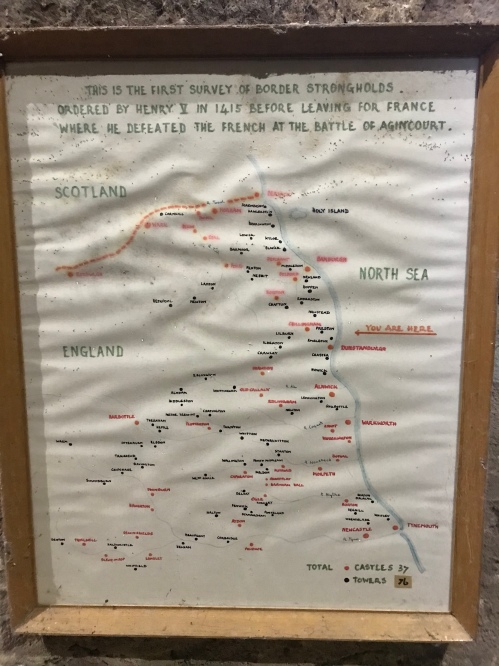
It matters little; but there were a lot of them – nearly eighty, in fact. So they were rather important in this part of the world… The hand drawing from the Tower’s museum shows the location of the fortified dwellings in Northumberland, most of which were towers. The original of this chart was drawn up by Henry V, just prior to his departure for France and the victorious battle of Agincourt.
Many of the fortified towers were constructed during the frequent wars between England and Scotland, which ended with the Act of Union in 1603 – after James I came to the English throne. In the sixteenth century, while the rest of England enjoyed relative peace, Northumberland – the eastern border county with Scotland – remained on a state of alert due to a scourge called the Border Reivers, and the towers saw a second lifetime as an essential way for the landed gentry to protect their people, servants and livestock.
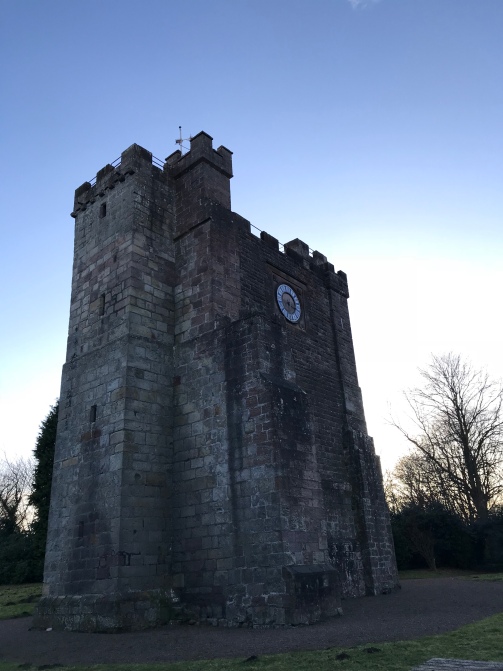
Reivers were lawless gangs, both sides of the border, who would steal, murder and rape their way across whole swathes of an undefended Northumberland and its disputed border with Southern Scotland.

One of the Preston Tower’s celebrated features is a combined great bell and clock. The bell is approximately four feet in diameter and weighs 500 kg. The mechanism for the bell, which strikes on the hour, is linked to the twin clocks on both sides of the Tower faces. The power is provided by a set of two giant stone weights whose ropes run most of the height of the building.

The clock mechanism on the second floor drives the twin clock faces on the north and south faces of the tower, and is based on the same mechanical design that powers Big Ben in London. The clock was added in the nineteenth century, which shows that the Preston Tower continued to be a place of historical interest for a long time.

As part of its function as a museum, Preston Pele Tower contains rooms which are furnished as they would have been at the time of its construction in the 14th century. The recreated interior spaces are sparse, and, to us, feel very basic. Being safe during a time of great insecurity was their central function.
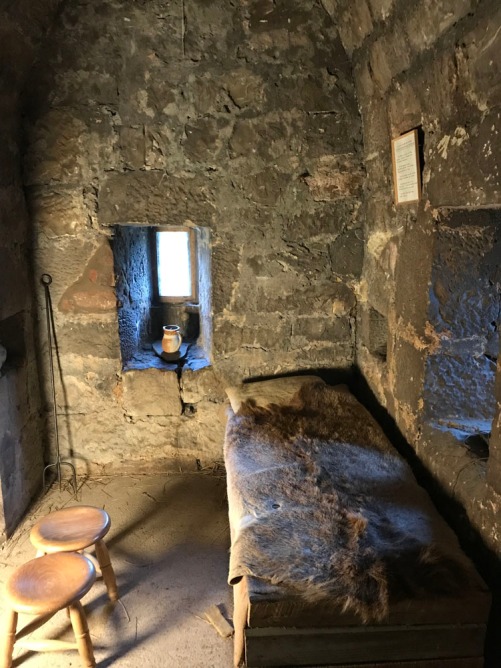
The basic cooking facilities are shown in the second of the two rooms.
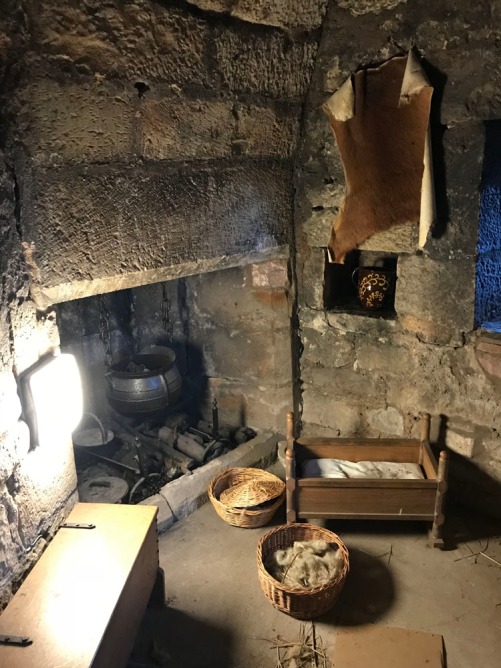
The staircase is a simple wooden structure that runs all the way to the roof on the east side of the internal wall.
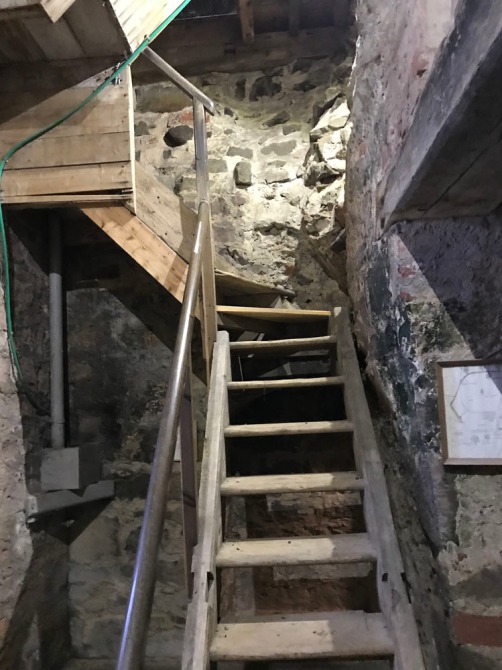
Once on the roof, the view of the countryside around is commanding.

Standing on the roof, in the last few minutes of our visit, the key I was looking for came to mind: Hope…
The Pele Tower was not a basis for aggression; its purpose was to defend the home and hearth, the family and those who worked for them, including the animals.
An image came to mind: that of the householder standing watch under the stars, scanning the horizon for reivers. The dawn is beginning in the east, but the sky is still filled with the strange darkness of the pre-dawn. He nods his head towards the coming light, then opens the door to descend to the chambers in which his family are sleeping, safe within the thick stone walls.

He pauses by the thin window, a defensive structure so narrow that a man could not pass through it. The shutters have not been drawn on this single light and he stops to consider the pale light, one final time. In that moment, I catch his thoughts in a line of poetry, a gift from the now that places such as these are so good at bestowing…
Through these thin lights, now so forlorn
Will one day stream a different dawn
It will take another hundred years – a time during which the rest of Tudor England will undergo transformation to modernity. But in this liminal zone of Northumberland, the change will be slower, as borders and reivers are set to rights.
But that day will come… and that fervent hope in my ghostly host’s eyes will empower it… And there is something very spiritual about that…
We left the Pele Tower quietly. Others had felt its unique personality. We were all tired, and the dinner booked at a nearby pub was very welcome.
Our mental and emotional preparation was complete. We had been witness to the internal architecture of the self as seen in these vast and very different structures of stone.
The sun would rise on a day dedicated to the Holy Island of Lindisfarne… and its ancient mysteries; the Companion Pilgrims were coming home…

The Preston Pele Tower is a privately-owned museum. It charges a very reasonable £2.00 admission and has car parking and toilets on site.
To be continued.
©️Stephen Tanham
Other parts of this series:
Part One, Part Two, Part Three, Part Four,
Stephen Tanham is a director of the Silent Eye School of Consciousness, a not-for-profit organisation that helps people find a personal path to a deeper place within their internal and external lives.
The Silent Eye provides home-based, practical courses which are low-cost and personally supervised. The course materials and corresponding supervision are provided month by month without further commitment.
Steve’s personal blog, Sun in Gemini, is at stevetanham.wordpress.com.
You’ll find friends, poetry, literature and photography there…and some great guest posts on related topics.

Reblogged this on Jordy’s Streamings.
Thank you, Jordis x
Thank you, Sue x
It blows my mind to see something this old! The oldest building in my state is a Mormon fort from 1855, and this blows it out of the water. I’m sure at some point in my life I’ll have the money to see stories castles in person and experience some history. Till then I’ll keep paying off my debts haha. Great post
Thank you, Jacob. I hope you get to travel as you would like. Very old things do have a certain magic about them – and it’s interesting to think how young are the eyes now seeing them, in comparison.